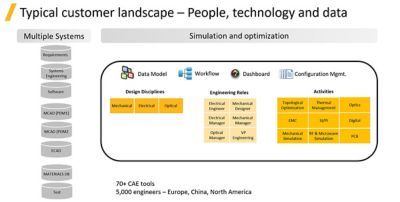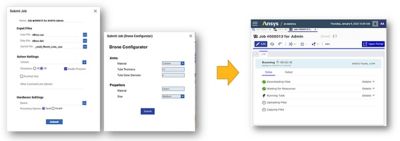-
United States -
United Kingdom -
India -
France -
Deutschland -
Italia -
日本 -
대한민국 -
中国 -
台灣
-
Ansysは、シミュレーションエンジニアリングソフトウェアを学生に無償で提供することで、未来を拓く学生たちの助けとなることを目指しています。
-
Ansysは、シミュレーションエンジニアリングソフトウェアを学生に無償で提供することで、未来を拓く学生たちの助けとなることを目指しています。
-
Ansysは、シミュレーションエンジニアリングソフトウェアを学生に無償で提供することで、未来を拓く学生たちの助けとなることを目指しています。
ANSYS BLOG
July 19, 2021
Improve Application Management and Streamline HPC Submissions
As more features and options are added to simulation software, simulation workflows are becoming more complex. A typical workflow might include gathering data (computer-aided design files, project requirements, material information), going through previous simulations, pre-processing, running and managing the simulation, post-processing, report generation and data archiving.
Add to this the transfer of simulation jobs to/from off-premises high-performance computing (HPC) centers when the job is too big for on-premises computers to handle, and the complexity increases. Many engineers struggle with manually configuring their simulation jobs submission to on-premise and off-premise HPC systems.
Ansys Minerva, powered by Aras, was designed specifically to make the entire simulation workflow easier, as I explain in the “Improving Application Management and HPC with Ansys Minerva, powered by Aras,” on-demand webinar. Minerva is an easy-to-use, all-purpose interface from which you can launch and monitor interactive and batch simulation jobs from Ansys solvers, third-party software, in-house custom software or a combination of all three.
Improving Application Management and HPC with Minerva
The biggest challenge in product design and development is the heterogeneous nature of the engineering landscape. Engineers from every discipline must be able to easily communicate and work together to solve today’s challenges. This means mechanical engineers must be able to easily collaborate with, for example, fluids engineers, electronics engineers and aerospace engineers to bring a product to market faster.
Furthermore, the diversity of software tools used by each type of engineer requires that multiple software packages supplied by different vendors be able to interact to produce valid results. Multiple handoffs of data between solvers can be overwhelming. So, all these tools must be connected in an automated way to make the process seamless, faster and more efficient.
Minerva Coordinates Software Interaction and HPC Submission
Minerva is an open, agnostic tool for any data format. Its flexible data mode works with all Ansys solvers and those supplied by other vendors. It can even handle custom software generated in-house for a product- or company-specific design challenge.
With Minerva, you can very easily streamline HPC job submission with web-based submission and monitoring. You can control the queueing of the jobs, efficiently monitor their inputs/outputs, and share and manage the resulting data. We have designed Minerva to be transparent, so you can see what it is doing and how your simulation is proceeding in-house or in a distant HPC center. Instead of a black box executing your applications, it gives you a smart way to look into the application and monitor its inner workings so you can make decisions regarding changes to parameters.
Minerva puts all data in one location for search and reuse, configuration, change management, review and signoff, and full traceability. It automatically coordinates all data handoffs between various simulation solvers, freeing you up to work on other tasks.
See Demonstrations of Application Management
This is just a brief description of what Minerva can do to make your simulation workflow easier. In the webinar, Rajiv Rath performs two live demonstrations showing how Minerva can improve applications management. One involves the use of Ansys Motor-CAD, Ansys Fluent and Abaqus to develop an efficiency map of an electric motor, along with a decibel level polar chart and vibration modes. The second shows how Minerva can handle batch, interactive and vertical application development for a drone design project.













